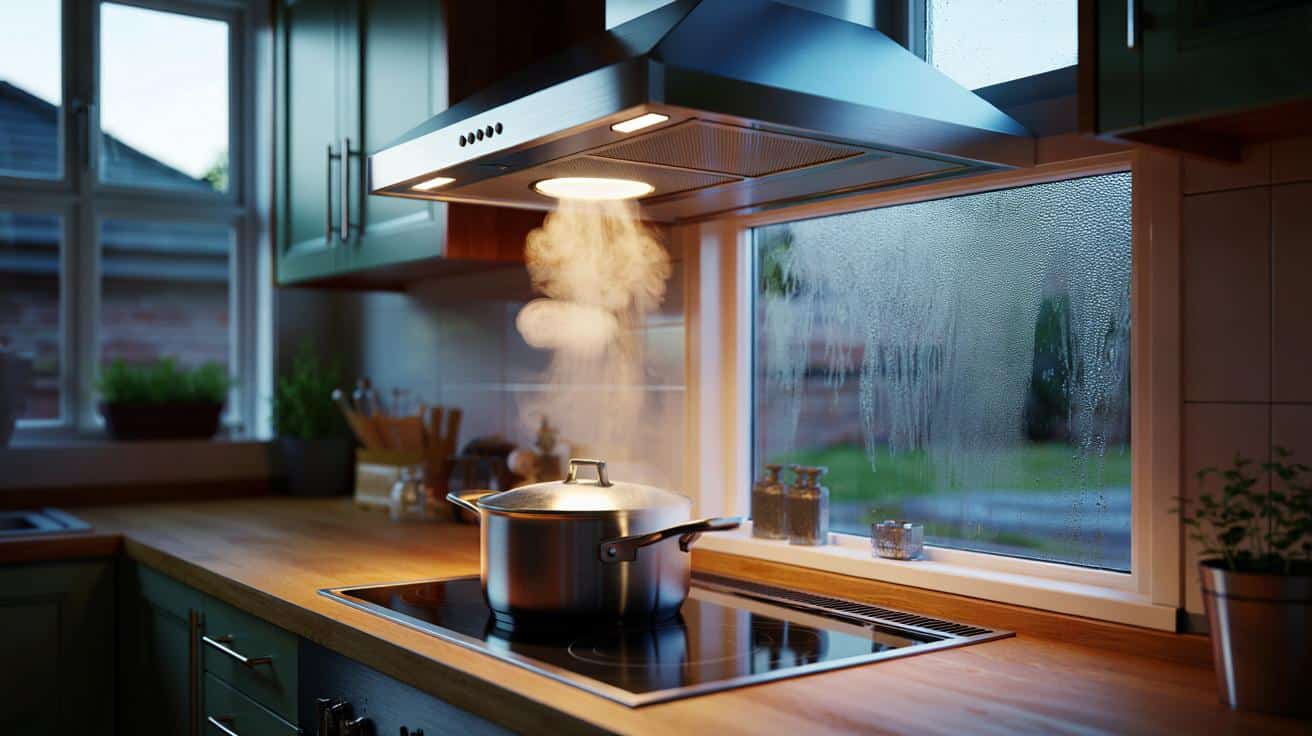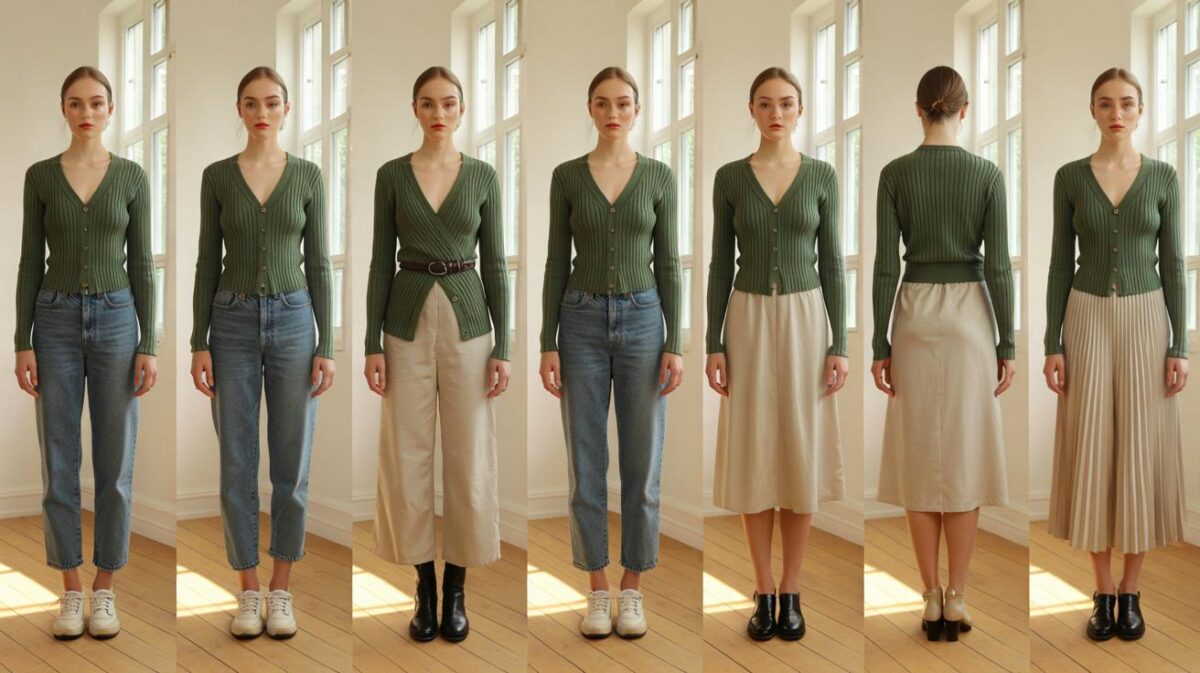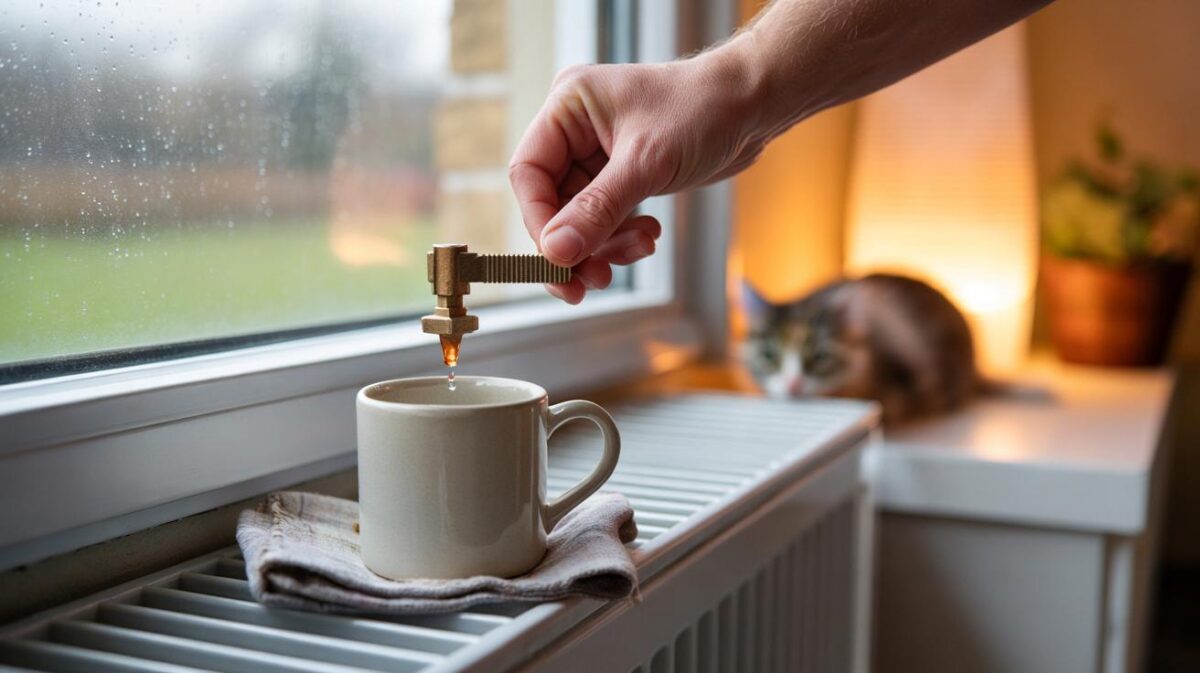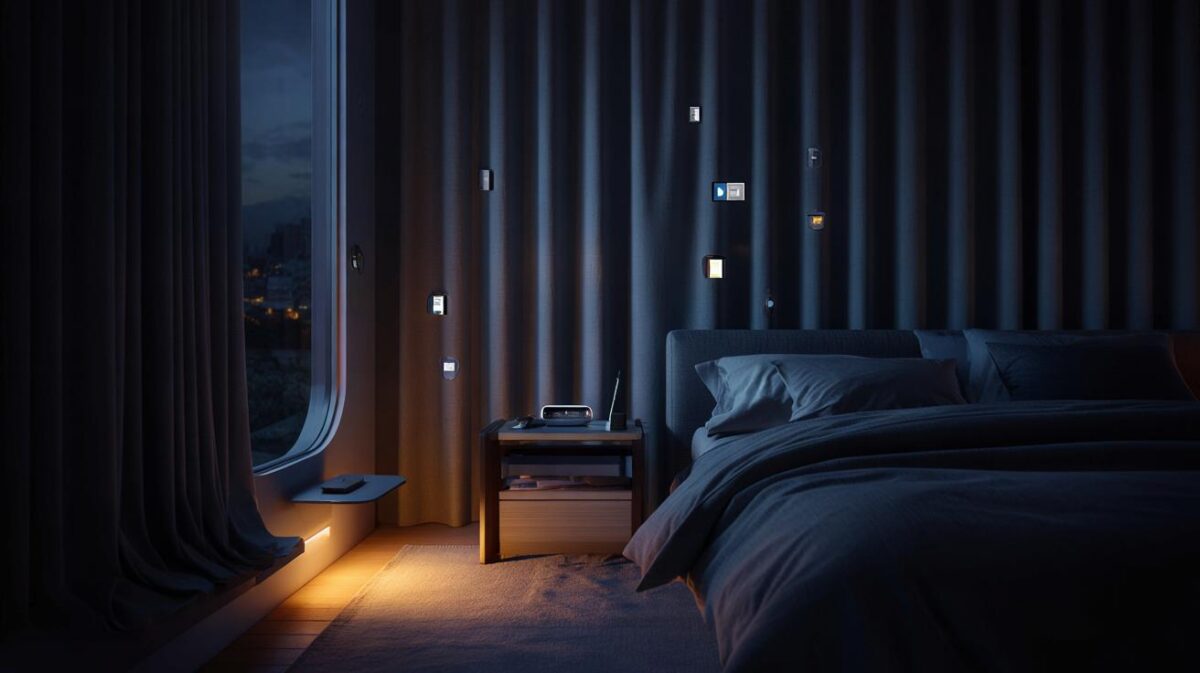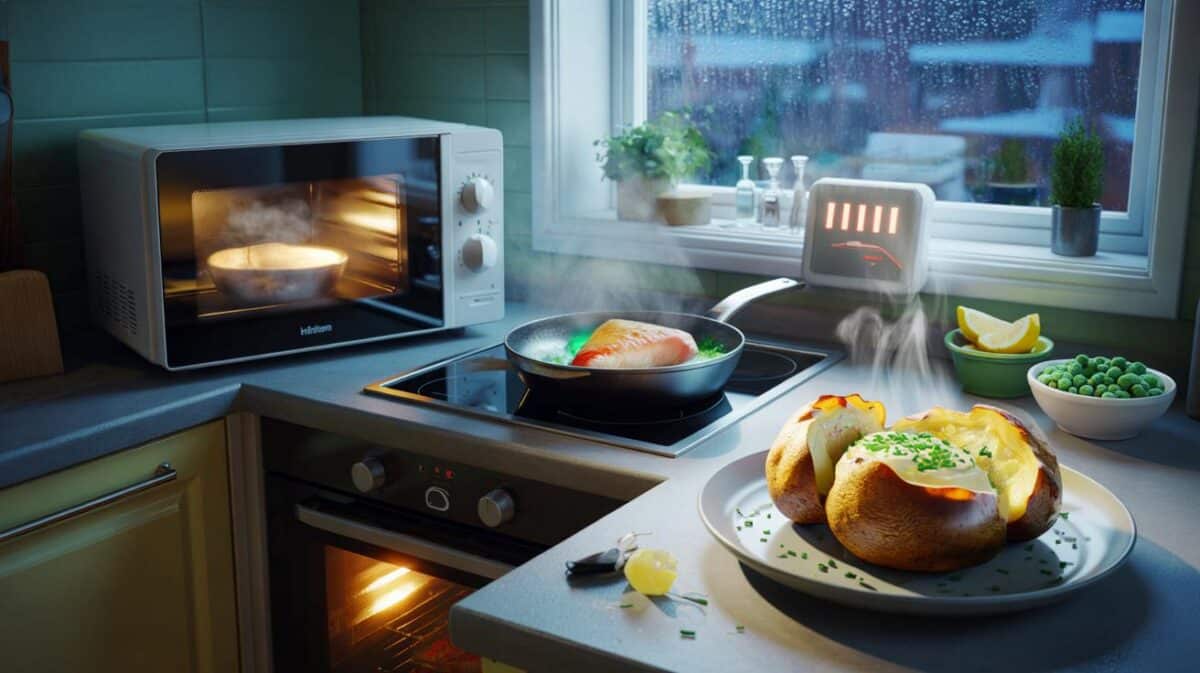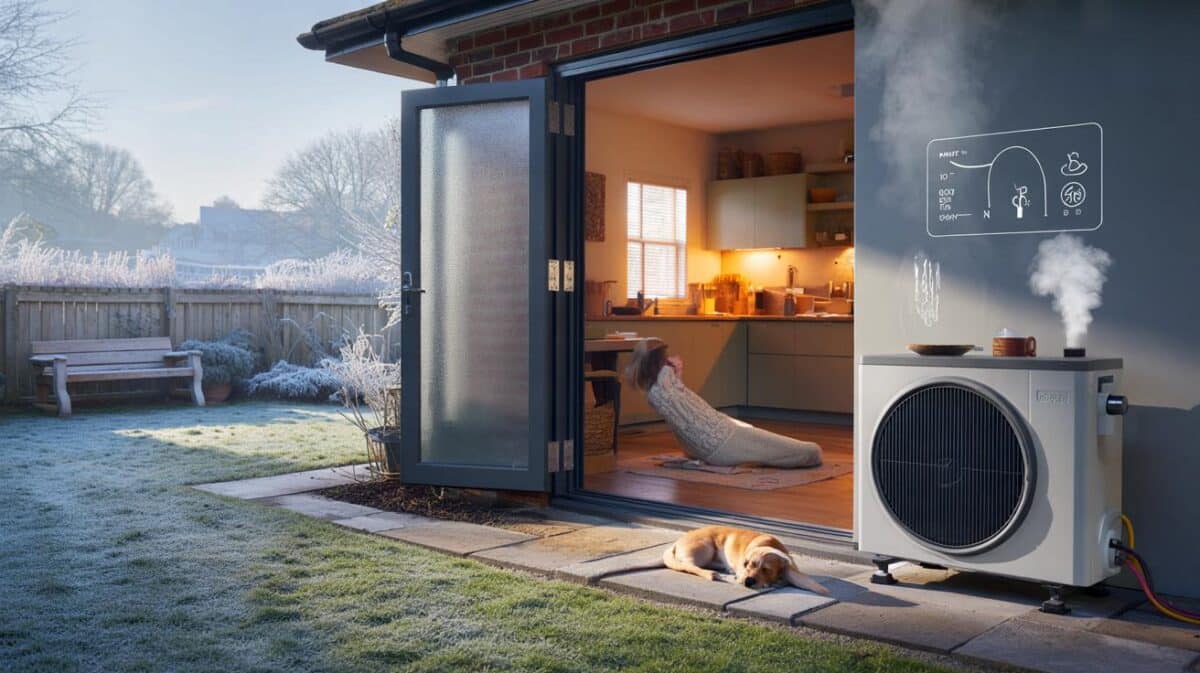The paint near the extractor starts to bubble. A faint, stubborn damp smell moves in by November and refuses to leave till spring. You wipe, you air, you buy yet another mould spray. And somewhere inside, you wonder if that noisy box above your hob is just for smells — or if it could actually stop the drips on the sill. It can. And it’s easier than you think.
It’s an ordinary Tuesday night. The kettle clicks off, a stockpot shivers into a full, rolling hiss, and the glass door blooms grey like late‑afternoon fog. You slide the window open a sliver, the room exhales, then the cold chases you back to the hob. A kid pads in asking for seconds; a cat parks itself under the radiator. The cooker hood sits there like a lazy referee. Then you tap it on, and the air changes. The answer hums quietly above your hob.
What condensation is really doing in your kitchen
Steam isn’t just steam. It’s moisture looking for the first cold surface to claim, and in British homes that’s often a pane of double glazing or a shaded corner by the cabinets. When that surface is cooler than the dew point of the room air, water drops out and clings on. Next comes peeling paint and that tell‑tale speckle of mould on the silicone by the window.
A typical household adds 10–15 litres of water to indoor air each day. Cooking can be a third of that, especially when boiling pasta, rice or stews for an hour. In a small kitchen, one heavy session at the hob is enough to fog every window and make the salts in plaster bloom white. We’ve all had that moment when a sleeve becomes the quickest “cloth” in the house.
Here’s the simple physics. Reduce the moisture in the air or warm the surfaces, and condensation backs off. A cooker hood beats the problem at the source by capturing wet air at the hob and either throwing it outside (ducted) or pushing it through filters (recirculating). Ducted extraction removes water vapour outright. Recirculating improves local air movement and filters grease and odours, but it doesn’t remove moisture on its own.
How to use your cooker hood for less condensation
Turn the hood on two minutes before anything hits a rolling boil. That pre‑pull creates a stream that catches steam immediately, not after the kitchen’s already muggy. Use the front burners directly under the hood’s centre, pop lids on pans, and keep liquids at a gentle simmer, not a geyser. When you’re done, drop to a quieter setting and keep it running. Run it for 10–15 minutes after you switch the hob off.
Go big when it matters, small when it doesn’t. High speed for boiling pasta, searing steaks or making stock; low speed for a gentle soup. Crack a window 10–15 mm or open a trickle vent to give the fan somewhere to pull from. If your hood recirculates, pair it with that small opening so the moist air has an escape route. Let’s be honest: nobody does this every day. Do it on the heavy steam days and you’ll still notice the difference.
Many hoods never get a fair chance because of tiny things. Move the pan so the rising steam sits under the filters, not off to the side. Don’t crowd the hob with tall pots that block the airflow. Keep doors to other rooms mostly closed so you’re not dragging steam across the whole house.
“Moisture control is source control,” says a veteran ventilation engineer I spoke to. “Catch it at the pot, and the windows won’t have to.”
- Clean the metal filters every month; swap charcoal filters every three to six.
- Use rigid 125–150 mm ducting, not thin, crushed flexi hose.
- Keep duct runs short, with gentle bends, and fit a back‑draft flap.
- Aim for 8–10 air changes per hour: a 300 m³/h hood is fine for a 30 m³ kitchen.
Does a recirculating hood still help?
Short answer: yes, but differently — and only if you help it. A recirculating hood won’t remove water vapour; carbon filters aren’t sponges. It does two useful things: it drags wet air away from your face and cupboards, and it mixes that air so it doesn’t park on cold glass in a single wet plume. Pair it with a cracked window or an open trickle vent during and after cooking, and you’ve created a gentle loop: hood lifts the steam, the vent lets it go. You’ll hear fans and ducts in reviews; what matters is the capture. When the fan begins early, the lids stay on, and the post‑cook run is non‑negotiable, condensation behaves. Steam is just future drips, looking for a cold surface. Change where the steam travels, and you change where it lands.
Make the hood part of a moisture‑smart home
Kitchens don’t exist in isolation. What you do at the hob sets the tone for the whole house, especially on cold, still nights. There’s a quiet pleasure in noticing the sill stays dry, the paint stays smooth, the glass clears quickly. It’s not about gadgets. It’s about small habits that add up: lids, early fan, a cracked vent, a gentle simmer, a few extra minutes of run‑on while you plate up. Share what works with friends who battle the same foggy windows. Sometimes the fix isn’t a new product at all, but using the one you already own like a pro.
| Point clé | Détail | Intérêt pour le lecteur |
|---|---|---|
| Start early | Switch the hood on 2 minutes before boiling, use high during heavy steam | Catches moisture at the source before it spreads |
| Keep it running | 10–15 minutes of post‑cook run‑on at a lower speed | Clears lingering vapour and cuts window fog |
| Maintain and route well | Clean filters monthly; use short, smooth, wide ducts | Delivers the performance you paid for |
FAQ :
- Does a recirculating hood reduce condensation?Not by itself. It filters grease and smells, moves air usefully, and helps if you crack a window so the moisture can escape.
- How long should I run the hood after cooking?Ten to fifteen minutes is a solid rule of thumb. Heavy boiling or frying? Stretch to twenty.
- What airflow should I look for?Aim for 8–10 air changes per hour. For a 12 m² kitchen with 2.5 m ceilings (30 m³), a 300 m³/h hood works well.
- Why are my windows still misty with the hood on?Turn it on earlier, use lids, centre the pan, and add a small window opening or trickle vent to complete the airflow loop.
- Do charcoal filters absorb water?No. They handle odours. Moisture needs a way out: ducting outdoors or a cracked window while the fan runs.
